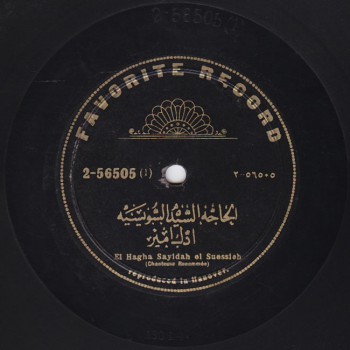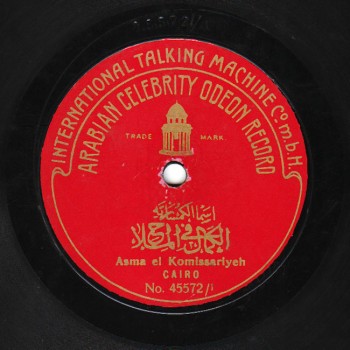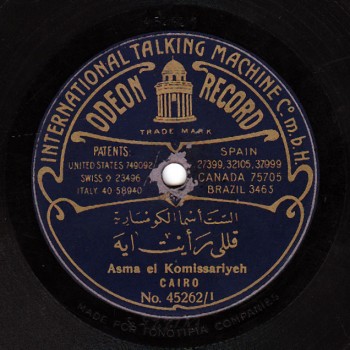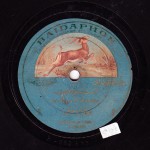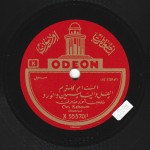The Arab Music Archiving and Research foundation (AMAR), in collaboration with the Sharjah Art Foundation (SAF), presents “Durūb al-Nagham”.
Dear listeners,
Welcome to a new episode of “Durūb al-Nagham”.
Today, we will resume our discussion about women who sang dawr, with Prof. Frédéric Lagrange.
I suggest we listen to another dawr, another sample in the voice and brilliant performance of Asma al-Kumthariyya. It is dawr “El-kamāl fī al-milāḥ ṣudaf” performed by many muṭrib, first and foremost by Sheikh Yūsuf Al-Manyalāwī, but also by Sheikh Sayyid al-Safṭī and Muḥammad al-Sab‘. Each brought his personal variations, becoming at once performer and author, and often trying to surpass the others. Asma al-Kumthariyya was of the same calibre and competed against them. Moreover, some elements in her recording of this dawr are unlike anything we have heard in the others’ recordings, such as the waḥāyid she invented that are particular to her… She brought her own personal version of this very lively dawr.
There is also the issue of the mixed takht: at the end of the recording, approximately on side 4, the henk is based on the su’āl and jawāb between the muṭrib and the madhhabjī –one or more. Early recording techniques do not specify the number of voices. One may think there are only one man and one woman, but there might be more. So, the madhhabjī include men and at least one woman or more.
Also, there is a strange section to the henk on the record: there is a jawāb performed by the men followed by a jawāb performed by the woman or women. I do not know if this was scheduled or not, yet it proves that this was a mixed takht.
So, was it a mixed takht that included blind male madhhabjī? Or was it a mixed takht because it was takht Odeon? She made the recording with Odeon and thus sang with their takht like all those who recorded with her during this period. Did this concept of a mixed takht also happen during concerts? Or was it limited to recording sessions because of the latters’ exceptional circumstances? What do you think?
The madhhabjī in takht Odeon was probably the ‘ūdist or the qānūnist… While the madhhabjī accompanying her were probably the members of her takht, and may have been female instrumentalists. Nevertheless, she certainly did record with takht Odeon, and anyone who recorded with Odeon during this period had to record with takht Odeon. The only exception was ‘Abd al-Ḥayy Ḥilmī who brought along his own takht, i.e. Ibrāhīm Sahlūn and Muḥammad Ibrāhīm.
She was probably accompanied by two members of her band who sang with her. Please listen carefully, and concentrate on the end of the performance of this great dawr…
(♩)
Now back to the ‘ālima and to Bamba Kashshar or Bamba al-‘awwāda (the lutanist) –were they the same person? As we said previously, we will never solve this riddle. Yet we can affirm that an unrenowned lady nicknamed Bamba al-‘awwāda recorded with different record companies. The name Bamba al- ‘awwāda was cited in the correspondence between Gramophone’s representative in Egypt and the parent company in the United Kingdom.
Naturally, at the beginning of the recording era, the record companies were trying to assess the value of the muṭrib as well as their ranking with the audience of customers. Bamba was ranked 4th among the muṭrib: 1st was Sheikh Yūsuf al-Manyalāwī, 2nd was Sheikh Salāma Ḥigāzī, 3rd was ‘Abd al-Ḥayy Ḥilmī, 4th was Bamba al-‘awwāda, and 5th was Muḥammad al-Sab‘ who I think was a mistake –he was a good muṭrib but not up to the level of Al-Manyalāwī, Ḥigāzī, or Ḥilmī. The point is that Sitt Bamba was ranked 4th among the masters. It seems that she was among the most famous artists in 1905-6-7.
Unfortunately, even if she did record with Zonophone and Odeon, she recorded very little. Yet she is among the few who recorded dawr “El-‘afū yā sīd el-milāḥ”…?
Yes. She recorded “El-‘afū yā sīd el-milāḥ” with Zonophone on a 30cm record 825C in 1906 or early in 1907. I think the only ones who recorded 30cm discs, i.e. “concert records”, that year with Gramophone are: herself, Al-Manyalāwī, Muḥammad al-Sab‘, and ‘Abd al-Ḥayy Ḥilmī.
An indication of her talent…
She was actually ranked 3rd because Salāma Ḥigāzī was not recording anymore with Gramophone, but with Odeon. So only three made concert records: herself and ‘Abd al-Ḥayy together, then Yūsuf Al-Manyalāwī but not in the same recording, then Muḥammad al-Sab‘ with Yūsuf Al-Manyalāwī. This further confirms the position of Bamba who was either cited as Bamba al-‘awwāda or simply Bamba, and sometimes Bamba “Waḥīdat Maṣr” (Bamba, Egypt’s one and only).
Let us listen to Waḥīdat Maṣr.
(♩)
We do not know who ḥājja Sayyida al-Suwaysiyya is. She is another unrenowned muṭriba who to my knowledge only recorded with German record company Favorite whose recordings were not as widespread as Odeon’s.
She sang dawr “Addak amīr el-aghṣān” that we know very well in Ṣāliḥ ‘Abd al-Ḥayy’s version. It was also recorded by ‘Abd al-Ḥayy Ḥilmī, but the known and well-liked version is Ṣāliḥ Abd al-Ḥayy’s. In this recording, we will notice Sayyida al-Suwaysiyya’s totally different and unique interpretation.
It was recorded by ‘Abd al-Ḥayy Ḥilmī, Muḥammad Salīm, Muḥammad al-Sab‘, and Sulaymān Abū Dāwūd. But her version is unique, personal, and very new as to the āhāt and the waḥāyid.
The only ḥājja we know about are those who recorded popular heritage, such as Zaynab al-Manṣūriyya, Ṣaḥba…etc. Still ḥājja Sayyida al-Suwaysiyya is the only one I came across who performed classical music. Also, note that the lady singing alone sounds older. It is the voice of an older woman, not one in her 30’s or 40’s.
When she sings the dawr, and compared to the other female voices, her voice is not jawāb but qarār.
(♩)
In a future episode, we will talk about the women who appeared in the 1920’s and decided to sing dawr in a different way as well as in a manner opposite to the principles of dawr singing, i.e. such as dawr were performed by Asma al-Kumthariyya or Bamba al-‘awwāda. I am talking about dawr in the voice of Munīra al-Mahdiyya, Fatḥiyya Aḥmad, Nādra Amīn, and finally Umm Kulthūm. Umm Kulthūm and Nādra Amīn may be closer to the spirit of the beginning of the century.
Listening to dawr in the voice of Munīra al-Mahdiyya will demonstrate that not all ‘ālima were capable of performing dawr with this same sobriety and professionalism.
Thus confirming Nagīb Maḥfūz’s opinion.
“Indeed. Bravo Nagīb”.
“Bravo Nagīb”
Dear listeners,
We have reached the end of today’s episode of “Durūb al-Nagham”
We will meet again in a new episode.
We thank Prof. Frédéric Lagrange and Nagīb Maḥfūz.
“Durūb al-Nagham”.
- 221 – Zakariyya Ahmed – 12 (1/9/2022)
- 220 – Zakariyya Ahmed – 11 (1/9/2022)
- 219 – Zakariyya Ahmed – 10 (11/25/2021)
- 218 – Zakariyya Ahmed – 9 (10/26/2021)
- 217 – Zakariyya Ahmed – 8 (9/24/2021)
- 216 – Zakariyya Ahmed – 7 (9/4/2021)
- 215 – Zakariyya Ahmed – 6 (8/28/2021)
- 214 – Zakariyya Ahmed – 5 (8/6/2021)
- 213 – Zakariyya Ahmed – 4 (6/26/2021)
- 212 – Zakariyya Ahmed – 3 (5/27/2021)
- 211 – Zakariyya Ahmed – 2 (5/1/2021)
- 210 – Zakariyya Ahmed – 1 (4/28/2021)
- 209 – W-al-Lāhi lā astaṭī‘u ṣaddak 2 (4/6/2017)
- 208 – W-al-Lāhi lā astaṭī‘u ṣaddak 1 (3/30/2017)
- 207 – Bashraf qarah baṭāq 7 (3/23/2017)

